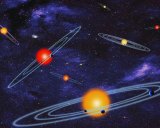NASA In Brief -- Scientists discover 715 new worlds; spacesuit helmet leak probed

Nearly 95 percent of these planets are smaller than Neptune, which is almost four times the size of Earth. This discovery marks a significant increase in the number of known small-sized planets more akin to Earth than previously identified exoplanets, which are planets outside our solar system.
Since the discovery of the first planets outside the solar system roughly two decades ago, verification has been a laborious planet-by-planet process. Now, scientists have a statistical technique that can be applied to many planets at once when they are found in systems that harbor more than one planet around the same star.
To verify this bounty of planets, a research team co-led by Jack Lissauer, planetary scientist at NASA's Ames Research Center in Moffett Field, Calif., analyzed stars with more than one potential planet, all of which were detected in the first two years of Kepler's observations -- May 2009 to March 2011.
The research team used a technique called verification by multiplicity, which relies in part on the logic of probability. Kepler observes 150,000 stars, and has found a few thousand of those to have planet candidates. If the candidates were randomly distributed among Kepler's stars, only a handful would have more than one planet candidate. Kepler observed hundreds of stars that have multiple planet candidates. Through a careful study of this sample, these 715 new planets were verified.
This method can be likened to the behavior we know of lions and lionesses. In our imaginary savannah, the lions are the Kepler stars and the lionesses are the planet candidates. The lionesses would sometimes be observed grouped together, whereas lions tend to roam on their own. If you see two lions it could be a lion and a lioness or it could be two lions. But if more than two large felines are gathered, then it is very likely to be a lion and his pride. Thus, through multiplicity the lioness can be reliably identified in much the same way multiple planet candidates can be found around the same star.
These multiple-planet systems are fertile grounds for studying individual planets and the configuration of planetary neighborhoods. This provides clues to planet formation. Four of these new planets are less than 2.5 times the size of Earth and orbit in their sun's habitable zone, defined as the distance from a star where the surface temperature of an orbiting planet may be suitable for life-giving water.
One of these new habitable zone planets, called Kepler-296f, orbits a star half the size and 5 percent as bright as our sun. Kepler-296f is twice the size of Earth, but scientists do not know whether the planet is a gaseous world, with a thick hydrogen-helium envelope, or it is a water world surrounded by a deep ocean.
SPACESUIT LEAK PROBED: The question had gone unanswered for months: Why did Luca Parmitano, an Italian astronaut, nearly drown during a spacewalk at the International Space Station last year?
After a six-month investigation, NASA spokesmen confirmed Feb. 26 that actually, there had been a previous leak and scientists failed to grasp the seriousness of the problem.
Roughly 44 minutes into a spacewalk July 16, Parmitano reported water inside his helmet. The ground team and crew members were unable to identify the problem. As Parmitano continued his work, the amount of water in his helmet increased and migrated from the back of his head onto his face. As he returned to the airlock, his vision was impaired and water entered his nose, a NASA report recounted.
Parmitano’s close call occurred during the second of two spacewalks in July. The first took place July 9 and there was a leak then too. At the time, astronauts and ground crew thought the problem was a leaking drink bag.
But another problem complicated matters: red tape.
The flight control team had a “perception that the anomaly-reporting process was a bit resource intensive. There was some schedule pressure with that [which] made them reluctant to invoke it,” said Chris Hansen, the space station’s chief engineer and chairman of the board investigating the mishap. “The point there is that they were reluctant to invoke it for an event that was believed to be very simply explained and corrected with the drink-bag failure.”
The upshot was that the event was not properly investigated, which could have prevented placing a crew member at risk a week later.
Hansen said that the root cause of the spacesuit failure is complex and still under investigation. Scientists traced the problem to contamination in a portion of the spacesuit called the fan-pump separator, but the source of the contamination has not been isolated.
Parmitano's ill-fated spacewalk clouded a subsequent repair mission.
In December, NASA scheduled urgent spacewalks to replace a broken cooling pump. Two astronauts -- Rick Mastracchio and Michael Hopkins – participated. Hopkins wore Parmitano’s spacesuit.
Components of the suit were changed. NASA officials said they were confident it was clean and ready to go. They had also put an absorbent pad in the back of the helmets in the event of another leak. Engineers figured a way to take plastic tubing and, strapping it together with Velcro, craft a makeshift snorkel, just in case.
Two spacewalks were scheduled to replace the pump. Mastracchio and Hopkins completed both without complication.
Like us on Facebook and tell us what you think.
Related:
NASA space telescope spots wobbly planet

